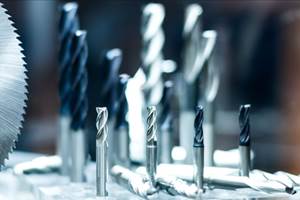The Value of a Job Quoting Checklist for CNC Machine Shops
A more comprehensive quoting process might enable you to win the right amount of the right type of work for your shop while eliminating any surprises that might otherwise pop up when production of a new job ensues.
Share



ECi Software Solutions, Inc.
Featured Content
View More




Autodesk, Inc.
Featured Content
View More
.png;maxWidth=45)
DMG MORI - Cincinnati
Featured Content
View More
Randy Makee quips that the job quotes Comstock Industries’ previous management team made were often haunted by the “ghosts of implied operations.” By those, he means operations that were not considered during the quoting process that were ultimately necessary to complete a part .
“A quote that simply lists ‘sawing, milling and shipping’ leaves a lot to the imagination, and introduces the opportunity for errors and unpleasant surprises once production of that new job starts,” he says. “It is also possible that the job might not be a good fit for the shop’s current capabilities, meaning it would be challenging or perhaps impossible to deliver parts on time and to the required specifications.”
Mr. Makee is currently the company’s COO. He came onboard shortly after Stephane Anglade purchased the CNC machine shop in June 2016. Because 40 percent of the Meredith, New Hampshire, shop’s work is new, non-repeating jobs, the men immediately recognized that a more sophisticated quoting process was not only warranted but required to grow the business. The new process ensures that the shop is taking on only the type of work that is in its wheelhouse and establishing a complete production process upfront before a job is bid on and possibly won. For the latter, the goal is to consider every detail with respect to engineering, production and inspection of a job so now there is nothing to question once it hits the shop floor. Having such a clear production picture is especially important because in addition to having 43 CNC machines, Comstock Industries has multiple in-house manufacturing capabilities including painting, powder coating, urethane bonding and assembly.
This has led to the development of the shop’s formal quoting checklist, which it now uses for every new job that merits quoting. In short, the checklist now has 45 questions compared to its original 15, and it ultimately verifies that there should be no excuses as to why a part cannot be made.
To complete a checklist for a new job to be quoted, the heads of the engineering, production, quality and customer service departments meet as a group to verify that their departments can complete all the steps required of them to produce the part. “All department heads must sign off that they can achieve the design, manufacture or inspection of the part,” Mr. Makee says. “At that point, there is no reason why we can’t efficiently produce that part.”
This more comprehensive quoting process has led to numerous benefits. Quoting has become more accurate because every requisite operation to complete a part has already been identified. Scrap and rework now is nearly nonexistent, because the entire production process is proven out during the checklist meeting. The shop quotes less frequently, because an initial comparison to a part’s manufacturing requirements and the shop’s capabilities might immediately show that the job is not a good fit. Design for manufacturability (DFM) is facilitated by having all department heads together examining a job during the checklist session.
That said, for this quoting process to succeed, every checklist question for each new job must be given thoughtful consideration. “It can be daunting to remain diligent, especially when the group has multiple jobs to quote on in a given day,” Mr. Makee says. “However, complacency kills the process. At that point, you might as well not have a checklist.”
Related Content
Inside Machineosaurus: Unique Job Shop with Dinosaur-Named CNC Machines, Four-Day Workweek & High-Precision Machining
Take a tour of Machineosaurus, a Massachusetts machine shop where every CNC machine is named after a dinosaur!
Read MoreWorkholding Fixtures Save Over 4,500 Hours of Labor Annually
All World Machinery Supply designs each fixture to minimize the number of operations, resulting in reduced handling and idle spindle time.
Read MoreThe Power of Practical Demonstrations and Projects
Practical work has served Bridgerland Technical College both in preparing its current students for manufacturing jobs and in appealing to new generations of potential machinists.
Read MoreAddressing the Manufacturing Labor Shortage Needs to Start Here
Student-run businesses focused on technical training for the trades are taking root across the U.S. Can we — should we — leverage their regional successes into a nationwide platform?
Read MoreRead Next
Registration Now Open for the Precision Machining Technology Show (PMTS) 2025
The precision machining industry’s premier event returns to Cleveland, OH, April 1-3.
Read More5 Rules of Thumb for Buying CNC Machine Tools
Use these tips to carefully plan your machine tool purchases and to avoid regretting your decision later.
Read MoreBuilding Out a Foundation for Student Machinists
Autodesk and Haas have teamed up to produce an introductory course for students that covers the basics of CAD, CAM and CNC while providing them with a portfolio part.
Read More


































.jpg;maxWidth=300;quality=90)












